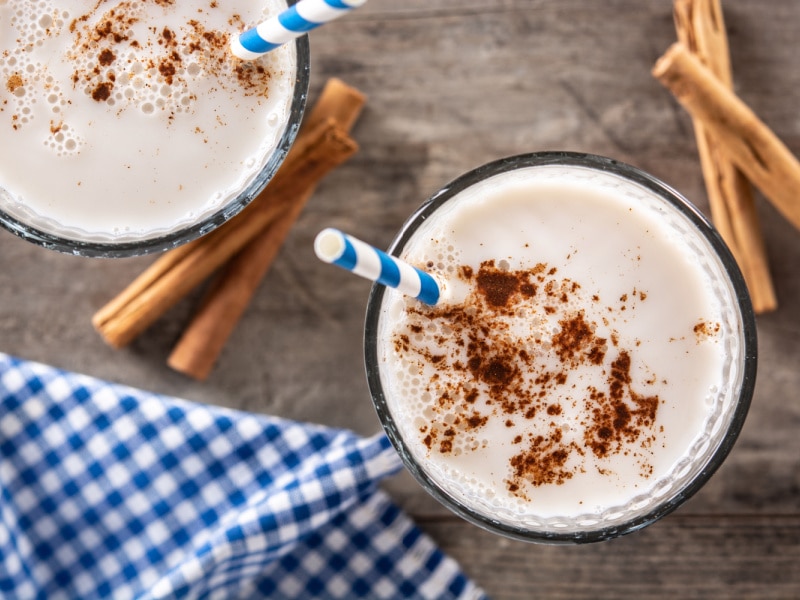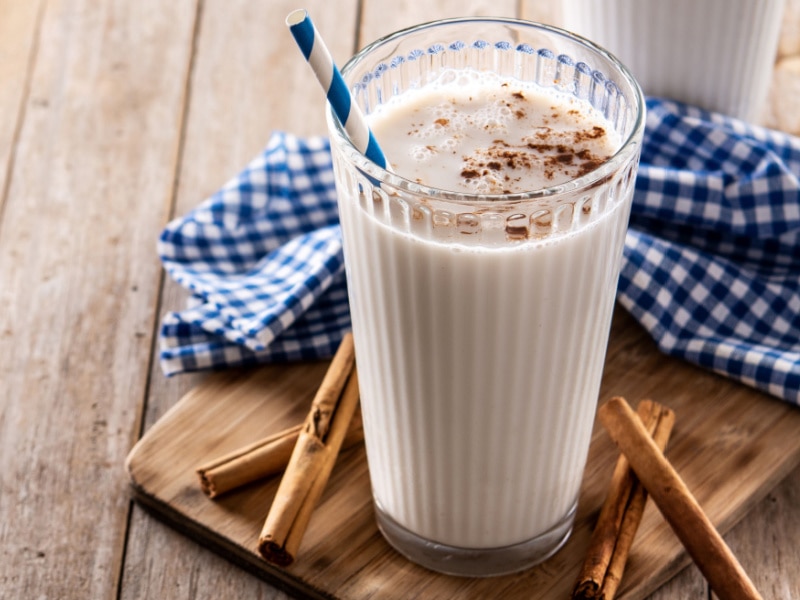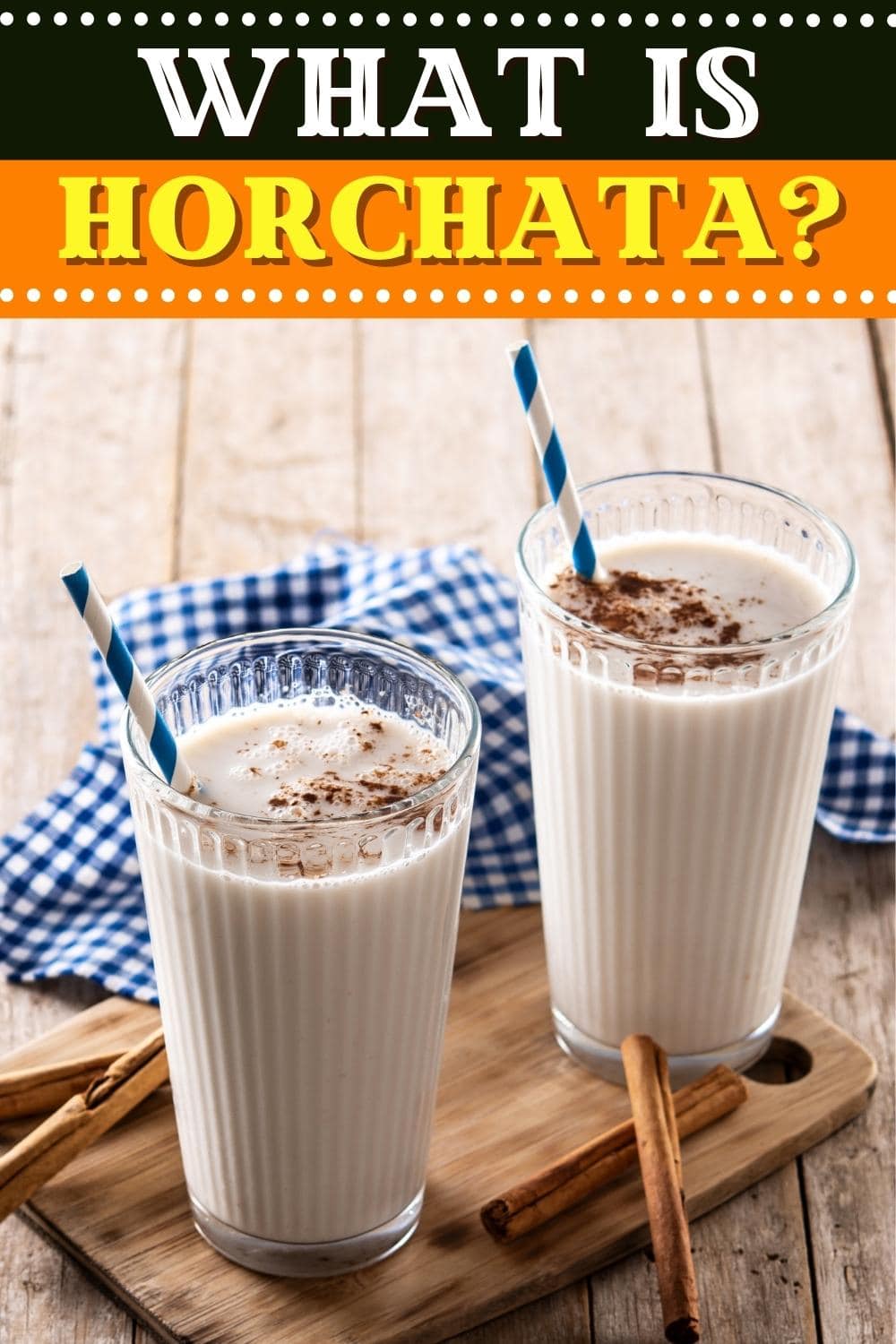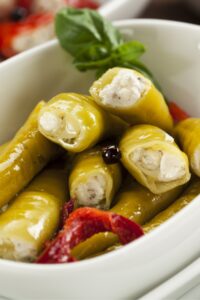From horchata-inspired desserts to cocktails, horchata is picking up steam in the United States. But what is horchata, exactly?
Horchata is a creamy nut-infused milk that earns a sweet punch from cinnamon and sugar. The origins of horchata go way to 2,400 BCE. Modern horchata is originally from the Valencia region in Spain but has gained popularity all over the world, especially in South America and Mexico.

Like any ancient recipe, horchata has changed over time.
In the Americas, many horchata recipes incorporate anything from rice and sesame seeds to pumpkin seeds.
So, let’s dive into what is horchata and all the different variations that span the globe.
What Is Horchata?
Horchata means “drink made from barley.” It’s creamy and sweet, with just a gentle kiss of spices.
It’s best served ice-cold, either over ice or straight up.
Think of horchata like vegan cereal milk.
It’s made by soaking grains (like white rice or tiger nuts) in water with cinnamon sticks and then blending and straining.
It’s delightfully creamy yet so light and refreshing. It’s the perfect sweet treat to sip on a hot summer day.
Add sugar and a garnish of cinnamon for a traditional Mexican horchata, and serve cold. That’s it!
You can drink it cold for an afternoon treat, use it in desserts (like ice cream), or mix it into a creamy cocktail.
Bonus points: it’s 100 percent vegan.
What’s excellent about horchata is that you can make it your own with extra flavors.
But more about that a little later.

Brief History of Horchata
If you live in the United States, you might assume that horchata is a classic Mexican drink. You would be wrong!
The origins of horchata span much farther back than Mexico.
This ancient beverage dates back to North Africa in 2,400 BCE.
Some historians believe this drink dates even farther back than 2,400 BCE, but no concrete evidence exists.
Did you know the Romans drank horchata?
They believed that this barely-infused drink was medicinal and drank it as medicine.
From what we know about modern nutrition, they weren’t far off.
This nut-infused drink is brimming with vitamins C and E, calcium, iron, and magnesium.
Originally, horchata was a Spanish beverage.
When the Spanish invaded the Americas, they brought their recipe for horchata with them.
However, since the ingredients for horchata weren’t widely available in Latin America, they swapped out some of the key elements.
Instead of tiger nuts, they used white rice or other available seeds.
This created the many variations of horchata that we know today.
Sometimes, not having a supermarket with rare ingredients is a good thing!
Over time, word of this fantastic beverage struck like wildfire all over Central and South America.
Regional horchata recipes use white rice, sesame, chia seeds, or floral herbs and spices.
They’re all different, but they are equally refreshing and tasty!
What Is Horchata Made Of?
The original Spanish recipe for horchata infused tiger nuts (aka chufa), water, cinnamon, and sugar.
When this drink traveled to the Americas, those ingredients changed.
Mexican horchata doesn’t incorporate chufa because it isn’t available. Instead, it uses white rice to create a creamy texture sans the tiger nuts.
What’s amazing about horchata is that you can drastically change the flavors and taste by tinkering around with different grains and seeds.
Chufa and white rice are great, but you can opt for barley, chia, pumpkin, or even cantaloupe seeds.

What Does Horchata Taste Like?
So, what does horchata taste like?
Horchata is a light, aromatic beverage best served on hot summer days.
It’s a fantastic creamy treat that isn’t overly heavy and a great way to cool off in the summer.
The creamy base of horchata is creamy, but it isn’t overly heavy like milk or heavy cream. It’s like drinking cereal milk!
It’s light and refreshing with just a gentle kiss of sweetness.
Of course, the flavor of your horchata depends on a few factors.
The grain or seed used to make the creamy base and your flavor additions matter.
Some recipes are light and not overly filling, while others taste like a whole dessert.
The base for your horchata creates new and exciting flavors.
For instance, Puerto Rican horchata utilizes sesame seeds instead of white rice.
It makes the horchata much nuttier and richer than those made with tiger nuts or white rice.
Horchata Varieties
Residents in the Americas had to make do with the ingredients that they had on hand.
If they couldn’t find tiger nuts, they used white rice, chia seeds, and sometimes even flowers.
Check out some of these fantastic Central American horchata variations below.
They’re all a little different, but the flavors are unique.
Spanish Horchata de Chufa
Spanish horchata is the OG. Many historians believe that this classic beverage came from North Africa.
It became popularized in Spain when the Moors invaded in the 8th century.
The original horchata recipe takes a little like sweetened almond milk.
It’s just as light, with a bit of extra sugar sweetness.
Tiger nuts are sweet and nutty with a hint of coconut flavors.
If you can find chufa, it makes the most amazing creamy horchata!
Central American Horchata
Saying there’s just one type of horchata in Central America is like saying there’s only one type of pizza in the United States.
From El Salvador to Honduras, the flavors of regional horchata shift.
However, there is one thing that all Central American horchatas have in common: they utilize morro seed or semilla de jicaro.
Morro seed is complex in flavor and yields a heavily perfumed horchata.
The morro seeds’ flavors deliver a horchata with black licorice and caramelly molasses notes.
Central American horchata is much more flavorful and bold than the classic recipe.
Puerto Rican Horchata
This style of horchata is very similar to the classic recipe.
There aren’t a lot of extra flavors, and it’s pretty mild and refreshing.
Puerto Rican horchata is unique because it incorporates a sesame seed creamy base.
The sesame seeds add earthy flavors that pair well with sugar and cinnamon.
This recipe is different because it’s much nuttier than the traditional horchata.
The nuttiness from the sesame seeds shines through for a sweet, nutty, and delicious horchata.
Ecuadorian Horchata
While most horchata recipes taste like simple variations on the original recipe, Ecuadorian horchata is different.
And Ecuadorian horchata is anything but simple.
Most recipes call for a blend of up to 20 different herbs and botanicals, yielding a beverage more like an herbal tea.
In Ecuador, everyone has a unique blend of herbs, including mint, lemongrass, roses, carnations, and chamomile.
It’s steeped like a traditional tea and is incredibly aromatic and floral.
Mexican Horchata
Mexican horchata is one of the most popular recipes in the Americas, especially in the United States.
While similar to the original Spanish recipe, it doesn’t incorporate tiger nuts.
Instead, the Mexican horchata recipe uses white rice for the creamy base.
Using white rice makes Mexican horchata a bit thicker and a little gritty.
It’s much sweeter than Spanish horchata and still incorporates classic cinnamon and sugar flavors.
Mexican horchata is thicker but has a milkshake-like sweetness that’s hard to resist.

How to Serve Horchata
In Spain, horchata makes a great merienda (or snack) to sip on in the afternoon.
It also serves as a great palette cleanser if your meal is particularly spicy.
Nothing helps calm overwhelming spices more than this sweet, delightfully creamy drink!
And while it makes a superb sweet afternoon treat, it makes an even better cocktail.
The dirty horchata, for instance, incorporates homemade horchata with a splash of coffee and dark rum.
What’s amazing about horchata is that it’s 100 percent vegan.
You get the creaminess from the nut milk that goes great in coffee.
It’s perfect as a sweet, creamy (and vegan!) afternoon treat or as an evening cocktail.
Having a pitcher of homemade horchata in the fridge is a must!










